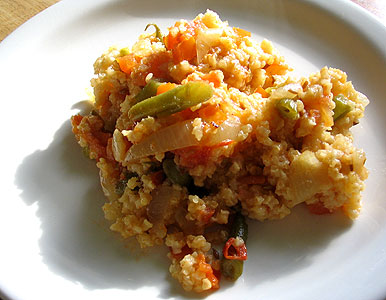I've been asked to provide a few recipes for spicy side dishes of a milder nature, so I cooked up this flavorful millet dish for dinner tonight. If you're into heat like I am, increase the amount of cumin and cayenne slightly, and add a dash of turmeric. It goes well with vegetables and bean dishes. Include a small bowl of yogurt with the meal, as yogurt has a cooling effect.
 Indian-Style Millet with Browned Onions and Green Beans Indian-Style Millet with Browned Onions and Green Beans |
Recipe by Lisa Turner
Cuisine: Indian
Published on March 23, 2007
Spicy Indian-style millet cooked with browned onions and green beans
Preparation: 10 minutes
Cooking time: 45 to 55 minutes
 Print this recipe Print this recipe
Ingredients:
- 1 cup millet
- 2 cups water
- 2 tablespoons sesame oil
- 1/2 to 1 teaspoon cumin seeds
- 1 small onion, cut into thin half rings
- 20 to 30 green beans, cut crosswise into 1/4-inch pieces
- 1 medium tomato, seeded and diced
- 1 teaspoon sea salt
- 1/4 to 1/2 teaspoon cayenne
- 2 tablespoons fresh lemon juice
Instructions:
Rinse the millet under cold running water and soak overnight in 2 cups of water. Heat the oil in a medium saucepan over medium-high heat. When the oil is hot, add the cumin seeds and stir for 10 to 15 seconds and then add the onion. Cook the onion for 8 to 10 minutes, stirring frequently, until browned. Add the green beans and stir for 30 seconds. Now add the tomato and continue to stir for 1 minute. Stir in the salt, cayenne, lemon juice, and the millet and soaking water. Mix well and bring to a boil. Reduce the heat to low, cover, and simmer for 30 to 40 minutes or until the liquid is absorbed. Remove from heat and leave covered for 15 minutes. Fluff with a fork and serve hot or warm.
Makes 4 servings |
 Indian-Style Millet with Browned Onions and Green Beans
Indian-Style Millet with Browned Onions and Green Beans Print this recipe
Print this recipe


7 comments:
And here I've been feeding all my millet to the wild birds that have adopted my balcony!
I would probably substitute olive oil for the sesame, as I pretty much use it exclusively (it's difficult for the genetic modifiers to play around with hundreds-of-years-old trees), and maybe play with the seasonings a bit, but this looks sooooo like tomorrow's dinner!
What's the purpose in soaking the millet, though? I saw in an earlier post that you soak brown rice, too, and I'm wondering why.
Olive oil is a fine substitute, and I invite you to include your modifications of this fine dish here in comments.
For more information about soaking grains, go here:
Grains require careful preparation because they contain a number of antinutrients that can cause serious health problems. Phytic acid, for example, is an organic acid in which phosphorus is bound. It is mostly found in the bran or outer hull of seeds. Untreated phytic acid can combine with calcium, magnesium, copper, iron and especially zinc in the intestinal tract and block their absorption. This is why a diet high in improperly prepared whole grains may lead to serious mineral deficiencies and bone loss. The modern misguided practice of consuming large amounts of unprocessed bran often improves colon transit time at first but may lead to irritable bowel syndrome and, in the long term, many other adverse effects.
Other antinutrients in whole grains include enzyme inhibitors which can inhibit digestion and put stress on the pancreas; irritating tannins; complex sugars which the body cannot break down; and gluten and related hard-to-digest proteins which may cause allergies, digestive disorders and even mental illness.
Most of these antinutrients are part of the seed's system of preservation—they prevent sprouting until the conditions are right. Plants need moisture, warmth, time and slight acidity in order to sprout. Proper preparation of grains is a kind and gentle process that imitates the process that occurs in nature. It involves soaking for a period in warm, acidulated water in the preparation of porridge, or long, slow sour dough fermentation in the making of bread. Such processes neutralize phytic acid and enzyme inhibitors. Vitamin content increases, particularly B vitamins. Tannins, complex sugars, gluten and other difficult-to-digest substances are partially broken down into simpler components that are more readily available for absorption.
So...phytic acid is a chelating agent (sometimes not so good), but it's also an anti-oxident (sometimes good)...
I need to do some homework.
Hmm I'm suffering from toxic chemical poisoning right now. Chelation sounds good. Need to do more research as to whether phytic acid is good for me in the short haul or not.
At any rate, this recipe is perfect as an introduction for my family.
Ah, fergy...you do NOT want a chelating agent in your food if you are suffering from a toxic level of minerals/metals already! This is not chelation therapy! It's precisely the opposite.
The chelating agent in the grain will bind and hold the excess minerals in your body, not flush them out. In your case, definitely soak the grain.
Fergy;
Yes, do soak the grain. I'm glad this recipe meets your approval and I'll be posting more like it over the next little while.
Okay, this worked (boy! did it work!):
Replaced the cumin, salt, cayenne, and lemon juice with a tablespoon or so of Patak's brand (no chemical preservatives) biryani curry paste. Also added a head of coarsely chopped fresh garlic at the same time as the onion.
Oh, yes! We're definitely going to do this one again!
Post a Comment